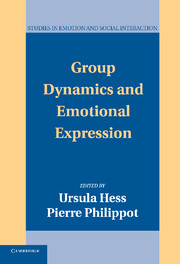Book contents
- Frontmatter
- Contents
- Contributors
- Introduction: The Tale I Read on Your Face Depends on Who I Believe You Are: Introducing How Social Factors Might Influence the Decoder's Interpretation of Facial Expression
- 1 Implications of Ingroup-Outgroup Membership for Interpersonal Perceptions: Faces and Emotion
- 2 When Two Do the Same, It Might Not Mean the Same: The Perception of Emotional Expressions Shown by Men and Women
- 3 It Takes One to Know One Better: Controversy about the Cultural Ingroup Advantage in Communicating Emotion as a Theoretical Rather Than Methodological Issue
- 4 Beauty Is in the Eyes of the Perceiver: The Impact of Affective Stereotyping on the Perception of Outgroup Members' Facial Expressions
- 5 The Perception of Crying in Women and Men: Angry Tears, Sad Tears, and the “Right Way” to Cry
- 6 Tell Me a Story: Emotional Responses to Emotional Expression during Leader “Storytelling”
- 7 Apples and Oranges: Methodological Requirements for Testing a Possible Ingroup Advantage in Emotion Judgments from Facial Expressions
- 8 Others' Faces' Tales: An Integration
- Index
- Cambridge Cultural Social Studies
- References
5 - The Perception of Crying in Women and Men: Angry Tears, Sad Tears, and the “Right Way” to Cry
Published online by Cambridge University Press: 06 August 2009
- Frontmatter
- Contents
- Contributors
- Introduction: The Tale I Read on Your Face Depends on Who I Believe You Are: Introducing How Social Factors Might Influence the Decoder's Interpretation of Facial Expression
- 1 Implications of Ingroup-Outgroup Membership for Interpersonal Perceptions: Faces and Emotion
- 2 When Two Do the Same, It Might Not Mean the Same: The Perception of Emotional Expressions Shown by Men and Women
- 3 It Takes One to Know One Better: Controversy about the Cultural Ingroup Advantage in Communicating Emotion as a Theoretical Rather Than Methodological Issue
- 4 Beauty Is in the Eyes of the Perceiver: The Impact of Affective Stereotyping on the Perception of Outgroup Members' Facial Expressions
- 5 The Perception of Crying in Women and Men: Angry Tears, Sad Tears, and the “Right Way” to Cry
- 6 Tell Me a Story: Emotional Responses to Emotional Expression during Leader “Storytelling”
- 7 Apples and Oranges: Methodological Requirements for Testing a Possible Ingroup Advantage in Emotion Judgments from Facial Expressions
- 8 Others' Faces' Tales: An Integration
- Index
- Cambridge Cultural Social Studies
- References
Summary
Authors' Note
Portions of this chapter were presented in a poster at the meeting of the International Society for Research on Emotions in Cuenca, Spain, in July 2002. We thank Randy Cornelius, Ursula Hess, and Pierre Philippot for their valuable comments on the manuscript. We also thank the undergraduate research assistants involved in collecting data: Susie Balazik, Maegan Dillman, Traci Lynn Frye, Lauren Kleha, and Dan Petrosky. We are grateful to Alice Eagly for providing access to her data on national stereotypes.
Correspondence regarding this chapter should be addressed to Leah R. Warner, Department of Psychology, The Pennsylvania State University, University Park, PA 16802. Email: lrw138@psu.edu.
Cell phones. You never know what news a call might bring. And in a public place it can be difficult to get a handle on the roller-coaster of emotions that ensues. Chris is upset. News of the divorce is surprising, yet not totally unexpected. Making matters worse, the phone call comes at a restaurant while Chris sits with friends at the table, surrounded by a roomful of strangers. The news is too much. And then it happens – along with the growing anger, tears well up in Chris's eyes.
Adults' tears can be powerful elicitors of concern and sympathy. Tears can also elicit scorn or suspicion regarding the crying person's motives. Crying prompts others to pay attention, which makes tears a powerful form of persuasion.
- Type
- Chapter
- Information
- Group Dynamics and Emotional Expression , pp. 92 - 117Publisher: Cambridge University PressPrint publication year: 2007
References
- 31
- Cited by



